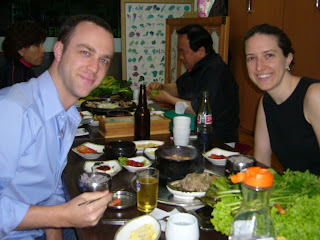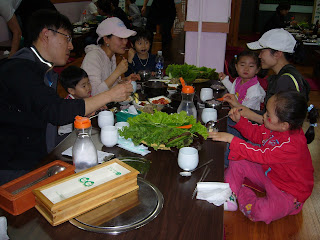 This post is actually about Korean food in general; food in Seoul is not that different from food elsewhere in the country - but Seoul food has a better ring to it, don't you think? When Ben was in town last weekend I had another chance to introduce a guest to this tasty, healthy cuisine. It's hard to know where to begin to describe the food; if you really want to know what it's like, you should come visit, too! But using this picture as a guide, I'll try to explain a bit about a Korean meal. (Once again, the photos are courtesy of a friend - thanks, Ben!)
This post is actually about Korean food in general; food in Seoul is not that different from food elsewhere in the country - but Seoul food has a better ring to it, don't you think? When Ben was in town last weekend I had another chance to introduce a guest to this tasty, healthy cuisine. It's hard to know where to begin to describe the food; if you really want to know what it's like, you should come visit, too! But using this picture as a guide, I'll try to explain a bit about a Korean meal. (Once again, the photos are courtesy of a friend - thanks, Ben!)The Korean traditions of eating and sleeping on the floor are becoming less common, but in a lot of restaurants you do still sit cross-legged on floor cushions. It's really gezellig (cosy, for any non-Dutch readers out there), especially in the winter when the floor heating is on. Here's a Korean family that was in the same restaurant - looks like a gezellig way to eat, doesn't it?
 Many people think of Korean food as spicy, and a lot of it is - note all the red in the dishes in the first picture (I think Ben said several times, "Man, they really like to put this hot sauce on everything, don't they?"). Koreans do use gochu-jang (pepper paste) in a lot of their food, and also slice HOT peppers into many soups and stews. Most people also think of kimchi when they think of Korean food - and indeed, no Korean meal would be complete without it. I like it now, but the appeal of this spicy, fermented cabbage is definitely an acquired taste. In this picture, the kimchi is in the top left corner of our table. Most Korean meals include a number of side dishes; here we had a couple varieties of kimchi, tofu, a sort of layered-omelette egg dish, and some kind of seafood smothered in - what else? Hot sauce.
Many people think of Korean food as spicy, and a lot of it is - note all the red in the dishes in the first picture (I think Ben said several times, "Man, they really like to put this hot sauce on everything, don't they?"). Koreans do use gochu-jang (pepper paste) in a lot of their food, and also slice HOT peppers into many soups and stews. Most people also think of kimchi when they think of Korean food - and indeed, no Korean meal would be complete without it. I like it now, but the appeal of this spicy, fermented cabbage is definitely an acquired taste. In this picture, the kimchi is in the top left corner of our table. Most Korean meals include a number of side dishes; here we had a couple varieties of kimchi, tofu, a sort of layered-omelette egg dish, and some kind of seafood smothered in - what else? Hot sauce.
We also had taenjang jigae - a spicy stew of tofu, squash, and onion in a soybean-based broth. Paired with rice, this is a great meal in itself - especially in winter because it's served in a hot stone pot (the steaming black bowl next to the bulgogi on our table). A number of Korean dishes are served that way, and Mom, I often think of you when I eat them - they're great for people like you who can never seem to have their food hot enough! It starts out much too hot to eat (for me, anyway), but it's nice that even your last few spoonfulls of soup never get cold.
I look forward to introducing my next guests (Kirsten, Mom, and Dad - I hope you're working up your appetites!) to Korean food. Crystal and I followed a day of shopping yesterday with sushi for dinner - and that also got me looking forward to the culinary adventures Kirsten and I will experience in Japan. Those of you who know me well know that I love to eat - and I think that trying different foods is one of the best parts of traveling. Now that I think about it, I'm surprised it's taken me this long to post about Korean food!